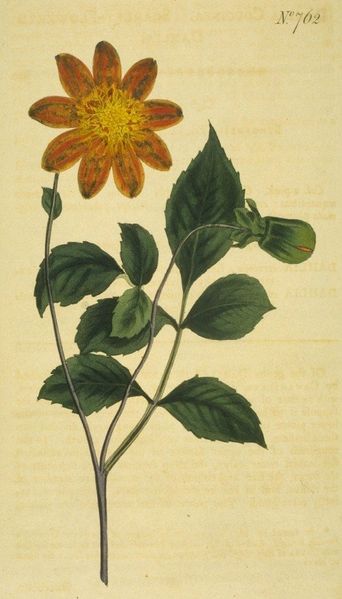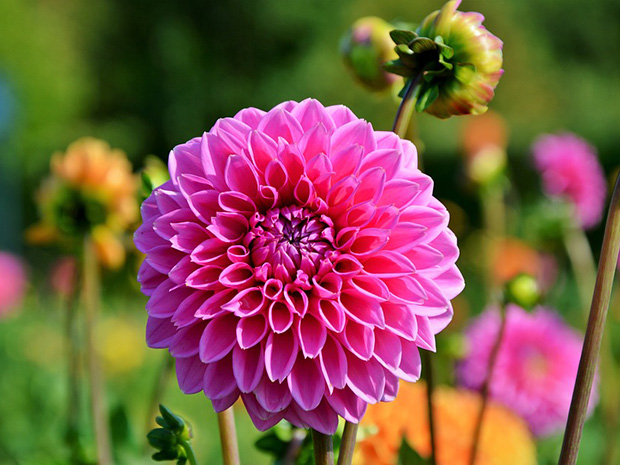It’s unknown exactly when dahlias reemerged, hybridized and beautified, in North America. Originally from Mexico, the tubers eventually found their way to Europe. They spent a few centuries making the rounds in botanical and horticultural circles, and eventually made it back, transformed, to North American soil and become one of our most exceptional garden flowers.

Scarlet-flowered Dahlia by S. Edwards, Sansum 1804. An example of an early dahlia.
Diversity is the hallmark of the dahlia flower. These impressive beauties not only range in height from 12″ to 8′, but their flowers can be anywhere from 2″ to 12″ across. The blooms can be simple with a single row of petals or hold rows upon rows forming a huge ball of color. You’ll find bi-color flowers, flowers resembling water lilies, flowers with curled petals, flowers with spidery petals, flowers with a combination of petal shapes and flowers that are just plain gigantic too. What makes dahlias so different from each other within the genus? Their genetic makeup is unlike most other plants. With more chromosomes and DNA sequences that are easily manipulated, they were ripe for hybridizing. The result is an enormous collection of wildly colorful flowers in a huge variety of forms.
Growing Dahlias
In the Northeast, we can count ourselves lucky that dahlias grow from tubers. Since our climate isn’t temperate enough to leave dahlias in the ground through winter, we can still enjoy them with just a little added care. Planted in the spring after the last hard frost, dahlias bloom at mid-summer. You can get a jump on the season by planting the tubers up in containers first even if you’re transferring them into the ground later. Late March would be the time to plant up in containers.
Dahlias Step by Step
In the Spring:
- Start by selecting tubers in the early spring. There are many varieties so this task may take a bit of time!
- Pick a spot. Dahlias like well-draining soil and lots of sun. Do you have a place that could use a blast of color? I can always find a few! If you chose a large flowered dahlia, make sure it will have room. The foliage can very quickly reach 3-4’.
- Loosen the soil well when digging the hole for dahlia tubers. Mix in some nice compost and if you’re planting in clay, you’ll want to add some peat moss. Mix in some Espoma Flower-Tone while you’re planting.
- Follow the package instructions for depth and put tubers into the ground point down. Cover with soil and water in.
- For larger fast growing plants, stakes can be essential. Staking is easy! Just put a stake or two in when you plant your tubers and use some twine to attach when the plants are larger.
In the Summer:
- Look for your dahlias to begin flowering in mid-summer and continue blooming up until frost.
- Dahlias love food. They’ll need extra energy to continue making bigger tubers. Espoma’s Flower-Tone is the best choice. Swan Island Dahlias, one of the largest dahlia growers in the country, recommends it! After feeding at the time of planting, feed again within a month, then 3 weeks after that.
- Dahlias make wonderful cut flowers. Don’t worry about cutting off a stem; the buds will keep coming until frost.
In the fall:
- After a killing frost, you’ll see that dahlia plants have died. Simply pull the plant out of the ground, cut the dead foliage off to 2” or 3”, wash off the tubers and dry them in a sunny window.
- Toss tubers into a paper bag with some peat moss or sawdust and store where it’s cool, but doesn’t freeze.
- Next spring simply replant and once again be thrilled with your dahlias.
Is it worth it? You bet!
These are on of my favorite flowers for so many reasons; big dramatic flower forms and color; they look amazing in containers; I can re-site them from year to year and garden pests rarely bother them. I hope I’ve persuaded you to try them!

